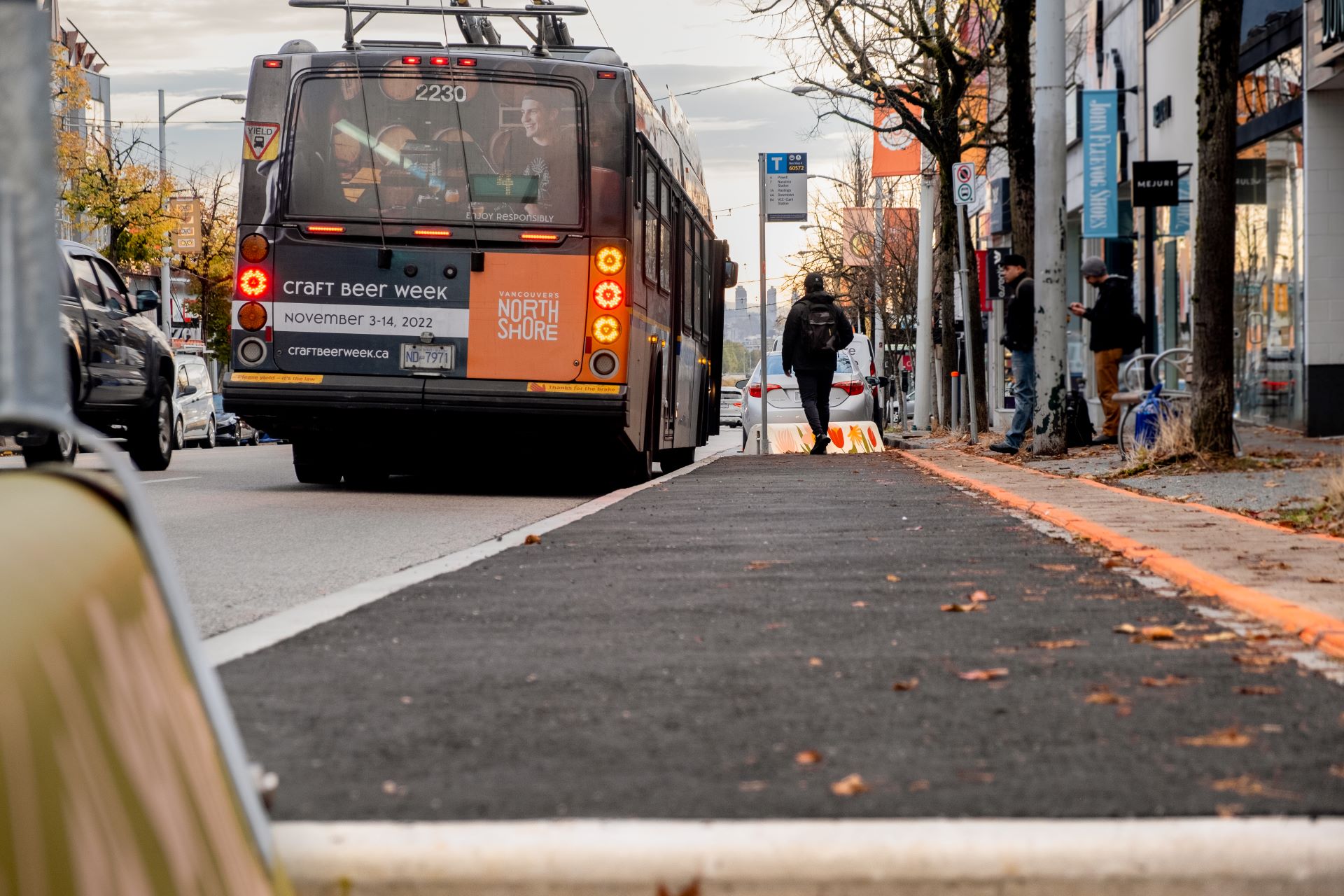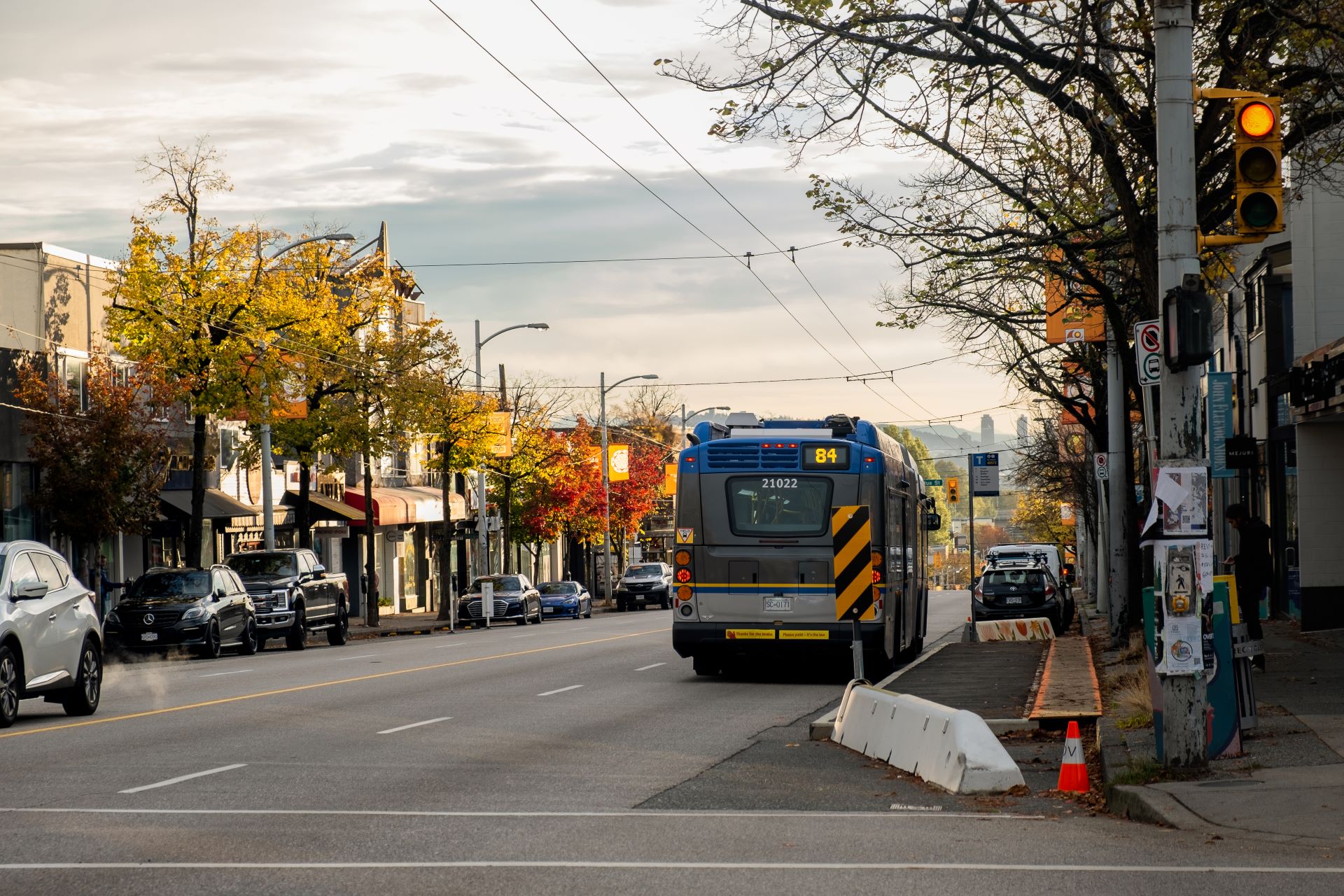Bus riders along West 4th Avenue in Vancouver get a speed boost
Bus riders along West 4th Avenue in Vancouver get a speed boost

Customers who ride the 4 Powell/Downtown/UBC, 7 Nanaimo Station/Dunbar, 44 UBC/Downtown and 84 UBC/VCC–Clark Station bus routes are now experiencing a more reliable commute through West 4th Avenue in Vancouver.
This is the result of recently completed “bus bulbs” to improve bus speed and reliability.
What’s happening: The City of Vancouver has constructed six bus bulbs along West 4th Avenue, between Balsam Street and Burrard Street.
Bus bulbs extend curbs into the parking lane so that buses can pick up or drop off customers without exiting the travel lane, which is a source of delays for buses.
Although up to 35 per cent more customers are using these stops since its construction, the bus bulbs have reduced travel times by as much as 10 to 20 per cent through this most congested part of the corridor.
Why it matters: In 2019, we published the Bus Speed and Reliability Report. It identified the West 4th Avenue corridor as one of the top-20 corridors contributing to person-hours of delay (PHD) in the region.
The corridor has extensive commercial areas featuring on-street parking, higher densities of traffic signals, and pedestrian activity — all of which contribute to localized congestion. As well, while portions of West 4th Avenue has six lanes, the two median lanes are often taken up by left turns and the curb lanes by parking. This means buses pulling out of stops are sometimes trapped by vehicles using the one practical through lane — one out from the curb.
By the numbers: PHD is a customer-focussed metric that is calculated by taking the average delay and multiplying it by the number of passengers who experienced it. The 2019 report found:
- The total length of West 4th Avenue corridor is 7.4 kilometres and it experiences 303 person hours of delay.
- Bus routes provide a combined 20-24 buses/hour along the corridor.
- 8.8 per cent of customers traveling by bus in Vancouver use buses that travel through this corridor.
- In other words, about one in 12 bus riders in Vancouver are affected by the performance of this corridor.
The big picture: Buses are the workhorses of the transit network. Every day more than half of Metro Vancouver’s transit customers use the bus. However, traffic congestion greatly affects the speed and reliability of buses and also increases the cost of providing transit service, which ultimately reduces the amount of service we can provide to our customers. There’s four things we’re doing in collaboration with our partners:
- Bus Stop Balancing involves carefully consolidating or removing bus stops that are too close together, in order to improve travel times and reliability for bus customers. As the name suggests, Bus Stop Balancing aims for a balance between convenient access and effective service.
- Bus bulbs are sidewalk extensions that allow buses to serve customers from the travel lane. Bus bulbs improve travel time and reliability by eliminating delays caused by merging into and out of the travel lane at bus stops. Bus bulbs also create more space for waiting and walking.
- “Lines and signs” are small changes that can make a big difference to bus delay. For example, adding turn lanes, restricting turns where turn lanes are not available, and giving buses easy access to the front of the queue can significantly improve travel times and reliability for our customers.
- Bus lanes are traffic lanes which are reserved for buses, marked by signage or paint. They can sometimes include other specific road users such as cyclists and HOV users. Bus lanes may operate during peak periods or all day.
The bottom line: TransLink and our municipal partners have a vital role to play in addressing the challenge of bus speed and reliability throughout the region. The new bus bulbs along West 4th Avenue, delivered in partnership with the City of Vancouver and the Kitsilano 4th Avenue Business Improvement Association, is the latest project addressing this challenge.







aaa
It amuses me how the animation portrays (true to life) two cars illegally entering the intersection behind the bus at 0:25.
TransLink still talks about ” Bus Stop Balancing ” . They stop doing it by bus route number. They just take away our bus stops without any consultation, one by one..
There are many better ways to speed up our buses.
Bus bulbs started in 1997 in Vancouver. The city has paid for them for many years.
Now TransLink is trying to take credit.
We need at least another 100 bus bulbs in the City of Vancouver.
At least 75% of transit riders use the bus, not the over 50% that TransLink wrote in the above article.
Great job! kudos to Translink for working for commuters.
Excellent work Translink and the City of Vancouver! And a nicely written article too.
Bus bulbs slow the traffic behind the busses. Busses should be phased out and replaced with driverless pods when they are available.
The bus stop balancing project could be expanded much more across the bus network in a fairly short period of time considering it mainly consists of discontinuing stops that are too close to each other and relocating bus stop poles. The municipalities don’t seem to really care about relocating the shelters because there’s still discontinued bus stop shelters along the four bus routes that have been part of the bus stop balancing project as late as January 2022. All-door boarding would also be nice.
so called “bus stop balancing” removed popular stops and broke useful connections (7-9-14-99 at Bwy&Alma). without any consultation or customer feedback. and the promised bus speedup was negated by buses sitting for 5 minutes or longer at “timing spots” getting on and off Granville St bridge. the shelters and benches have not moved to the new stop locations. but the new stops sure look pretty on the map.
This story doesn’t mention or show an example with a bike lane. What is the effect of bus bulbs on bike traffic? When passing a bus stopped at one of these stops I assume the cyclist is forced into left lane (or made to wait). How are translink balancing the priorities of improving bus service and encouraging cycling?